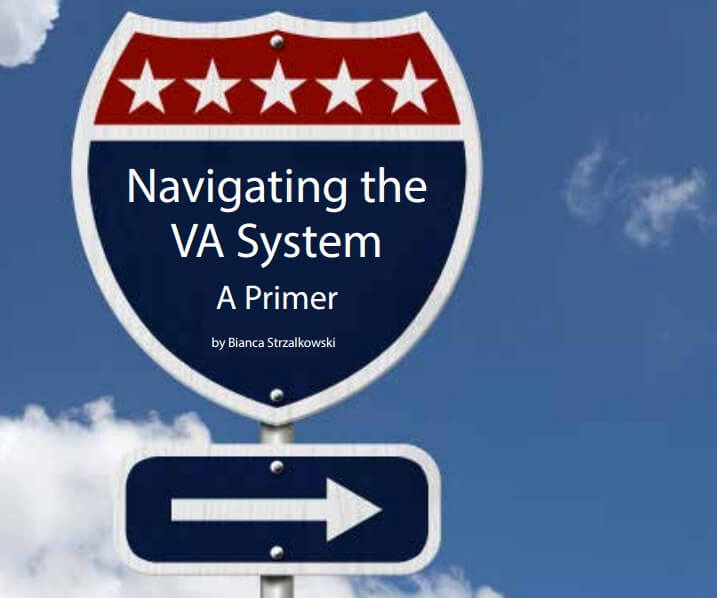by Bianca Strzalkowski
The Department of Veteran Affairs forecasts more than one million service members will transition from military to civilian life over the next few years.
The service branches aim to prepare personnel for this change through mandatory Transition Assistance Program (TAP) classes, which cover a host of need-to-know topics. Recently, a newly designed curriculum was added called Transition GPS (Goals, Plans, Success) featuring a section specifically on the VA called VA Benefits I and II. The topics include:
• education,
• health care,
• compensation,
• life insurance,
• home loans,
• vocational rehabilitation,
• employment benefits information and counseling,
• understanding the VA disability compensation process, and
• navigating eBenefits.
That’s an overwhelming list of information. At the point someone is ready for the big leap outside the structure of a military career, it is likely some details will become lost in translation. Barbara Morton, Deputy Director of the Veterans Experience Office, says in her ideal world, service members would learn about what the VA offers throughout their career versus at the completion.
“ … I would have all service members actually be really well-educated about VA and the benefits available to them while they’re still in service. My understanding is, right now, we don’t quite do that. We do that towards the tail end, meaning VA, with the TAP program,” Morton said.
Her office is responsible for interviewing veterans to understand their needs so that programs can be designed to meet those needs. She adds that the VA has refocused efforts to make navigating the department more user-friendly.
How to connect to accurate information
The services most commonly accessed by veterans are VA health care, life insurance policies, VA disability compensation, home loans, and education benefits.
John Medve, Executive Director, Office of Interagency Collaboration and Integration at the Department of Veteran Affairs, says service members and veterans can familiarize themselves with these programs and get follow-up information about procedures they are unclear about by downloading a copy of the Federal Benefits for Veterans Booklet.
“This booklet provides [a] comprehensive list of benefits, eligibility criteria, and contact information for follow-up with a VA representative. The online version has a by state resource finder capability to allow the veteran to contact a point of contact near them,” Medve said.
For someone who prefers to direct questions to a live person rather than sorting through that vast amount of information, Medve suggests three options:
1. The “contact us” tab on VA.gov provides a list of 1-800 numbers depending on the health care or benefits question,
2. The VA benefits book includes a complete list of 1-800 numbers where they can receive assistance, or
3. The on-line resource finder contains key staff information within 1898 VA facilities, and it is maintained on a regular basis. It is designed for ease-of-use, and categorizes information for browsing by state and administration, as well as by viewing through an interactive map of the United States.
Connect with VSOs
If reviewing the website or talking via phone is not your preferred method of communication, Barbara Morton says there are useful on-the-ground resources that provide veterans with the opportunity to engage in-person. Local veteran advocacy groups exist throughout the country.
“I would encourage a service member who’s recently separated to do is really connect with veteran service organizations (VSOs) … there’s national VSOs, there’s state VSOs – those are great advocates to help a veteran kind of navigate the process, and a lot of them are veterans themselves,” she said.
TIP: RESEARCH THESE ORGANIZATIONAL WEBSITES TO FIND A CHAPTER NEAR YOU
Disabled American Veterans (DAV): https://www.dav.org/
Iraq and Afghanistan Veterans of America (IAVA): http://iava.org/
Veterans of Foreign Wars (VFW): http://www.vfw.org/
American Legion: http://www.legion.org/
Military Order of the Purple Heart: http://www.purpleheart.org/
Many of these VSOs have staff on hand who can help with functions of filing paperwork, getting appointments setup, and deciphering the policies and procedures.
My VA Community Within the last two years, the VA has added a more localized program called My VA communities. Morton says there are roughly 80 locations around the U.S. consisting of political leadership, VA leadership, local VSOs, and veteran advocates who meet to help answer any questions or concerns veterans may have.
TIP: SEARCH FOR A MY VA COMMUNITY NEAR YOU ONLINE AT .
Whether you are about to exit the military or have been out for some time, there is a likelihood that you are inundated with information about resources for veterans. While there is no shortage of programs, fielding through the complexities of the services offered by the VA can be confusing or frustrating. The Department is working to streamline its processes to accommodate the veteran as a customer. If you are unsure about the steps to take to access your earned benefits, rely on those veteran service organizations that are setup to meet your needs on a local level.
—Bianca Strzalkowski is a military spouse and freelance writer who lives in North Carolina

